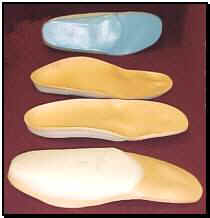Care Of Arthritic Feet
Published in M.D. News September 2001
Written by Michael Lukowsky, Certified Pedorthist
By Michael Lukowsky, Certified Pedorthist
The Arthritis Foundation reports that 37 million people in the United States are affected by arthritic conditions. Osteoarthritis is the most common form of arthritis, which is a general term denoting wear and tear of the joints. The feet are more susceptible to osteoarthritic conditions because each foot has 26 bones, 2 sesamoids, over 30 joints, and 42 muscles. Force = mass times acceleration. If a 150-pound person walks one mile in a day at a rate of 2.23 miles per hour, each foot would endure 400,000 pounds of force. That equates to 146,000,000 pounds of force (32,808,988 Newtons) per year! The result is inflammation, redness, and pain in the joints, especially the metatarsal phalangeal joints. The shoe is the only interface between these huge forces from the ground to the feet. Good footwear and custom orthotic devices will greatly reduce pain.
We see patients that are often unaware they have so many options available to reduce their pain through pedorthics. The selection of footwear today is better looking than ever. The manufacturers have responded to the aging population and are producing footwear from sandals to work boots that will accommodate custom orthoses. The manufacturers of orthopedic supplies have also responded to the demand of sheet goods in varying colors and densities. The two types of orthoses most commonly made for arthritic patients are dual density plastazote reinforced with Poron and a tri-laminate Puff/Poron/cork. Plastazote is now available in 3 densities with the softest being #1, often referred as soft tissue supplementation. The second density is #2, which is slightly firmer and gives soft support. The 2 different density plastazotes (#1 full foot over #2 to just posterior to the metatarsal heads) are heated and sealed together and custom molded directly to the patient s feet. This opens the metatarsal phalangeal joints, reduces pressure on the metatarsal heads and will accommodate nodules. The patient then wears the orthotic device for 2 to 6 weeks and returns. The # 1 plastazote will show areas of high pressure. The orthoses are then modified to reduce the areas of high pressure and then Poron is added to the bottom. Poron is the most shock absorbing material and will not compress. This type of orthoses will last about one year. All three materials are available in most colors. Thus, we can make a black orthoses to go into a black sandal.

The second orthotic device for arthritic feet are tri-laminate. This type is used when more control is needed. The materials are Puff on top, Poron in the center and Puff and cork are on the bottom. The Puff and Poron are very cushioning and the cork is used for posting and control. If an arthritic patient is severely pronated and is flexible enough to control and the mid metatarsals are plantar flexed as a result of the pronation, a tri-laminate is an excellent choice to reduce the pain at the metatarsal joints. The tri-laminate orthoses will last several years.
Other options are shoes with metatarsal support built in, pre-made orthotic devices, metatarsal pads, shoes with Lycra tops that stretch around deformities, silicone gels, and heavily cushioned socks. If the deformity is severe enough that the patient has loss of motion in the forefoot and pain occurs during toe off, rocker soles are add to the bottom of almost any shoe so the patient can ambulate without having to bend the forefoot. Springlites (thin carbon fiber plates) are also an appropriate for this situation.
In cases where the feet are severely deformed, custom shoes are an option as well. A cast is made of the entire foot and ankle. A last is the made from the mold of the foot. The shoe is then made accommodating all deformities and has a removable, replaceable plastazote orthoses.
With fat pad atrophy and severe joint pain, arthritic patients appreciate anything to help reduce their pain. Prescribing orthopedic shoes, custom or pre-made orthoses, shoe modifications, or custom shoes, can make all the difference is an arthritic person s life and they will greatly appreciate your advice. With the advances in technology and the manufacturers realizing the demand, you can let the arthritic patient know orthopedic shoes are not ugly any more, there are many fashionable sandals, athletic, casual, work, and dress shoes with removable insoles. With a prescription, some insurance policies will cover these items.
Sole Control Orthotics and shoes for those arthritic feet in St. Louis, MO.
9120 Watson Road
St. Louis – Crestwood, MO 63126
636-536-9800